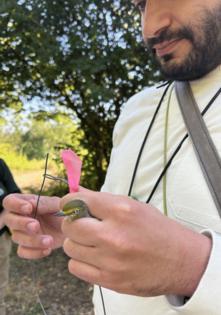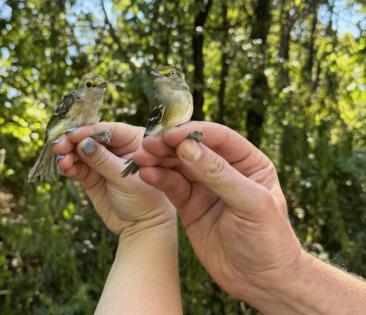Pittsburgh city birds outnumber suburban and country cousins in this count
Published in Outdoors
PITTSBURGH — Birds descend from the sky at dawn to take a break after their red-eye flight migrating south.
Where do they get breakfast and other meals to refuel for their journeys south, with some flying thousands of miles to reach their wintering grounds in South America?
During fall migration, Hays Woods, Pittsburgh's newest park, hosts more birds than comparable suburban and rural sites, Bird Lab's five-year banding survey shows.
At Hays Woods recently, wood thrushes and warblers paused for food and rest in greater numbers and diversity than expected.
The matchup between the three different environments during bird migration was deliberate.
The bird banding project helps researchers learn how migratory birds use local habitats at sites with different degrees of urbanization and human impact. The banding stations are mobile, allowing Bird Lab to strategically study a range of sites.
Bird Lab holds federal and state permits to band birds.
The three sites aren't pristine or birding hotspots, but rather pockets of suburban forests, regrowth at old strip mines and power-line meadows in an urban environment.
"They all are really everyday spaces," said Nick G. Liadis, Bird Lab founder and an avian conservation biologist. "This project collects data representative of a lot of green spaces in southwest Pennsylvania."
In its more than four years of banding, Bird Lab has recorded 76 species in Hays Woods, including its first mourning warbler a couple weeks ago.
Bird Lab scientists have observed other uncommon songbirds, including the olive-sided flycatcher and cerulean warbler — both migrants.
The other banding sites in the suburbs and rural areas netted fewer species and individuals.
In Butler, close to Chicora, on private property known as Twin Stupas, 67 birds were banded, while 68 were tagged on private woodlands in Upper St. Clair.
The Butler site has a higher percentage of migrating birds in the spring that breed through summer.
'Blip of green'
During just two days of banding a couple weeks ago, Bird Lab tallied up to 23 species of birds at Hays Woods, many of them migrants.
Liadis guessed that migrating birds, looking for a place to land, feed and rest, find Hays Woods attractive with its 626 acres perched above the Monongahela River surrounded by the city neighborhoods of Hays and Hazelwood, Mount Oliver, Baldwin and other communities.
"The birds are probably zeroing in on Hays Woods because it's a large blip of green in an urban area," he said.
"When daybreak comes, they are looking for the best habitat. Hays Woods is higher up in elevation with forest, power-line cuts that are meadows and woodland edges."
In the fall, various species of migrating birds gravitate to open areas near power lines flanked by trees and brush, Liadis noted.
During spring and fall migration, Bird Lab sets up 14 mist nests at three sites within Hays Woods and retrieves birds about every 30 minutes.
The 40-foot-long nets are lightweight and nearly invisible; they're strung up much like volleyball nets.
Once the birds are captured, Bird Lab bands them with small, almost weightless aluminum bands inscribed with numbers to identify them.
Scientists measure, weigh, determine age and measure the bird's fat on its abdomen. Fat reserves are essential for a successful migration.
"It's like running a marathon," Liadis said. "They need the extra calories to fuel their long-distance journeys."
The birds are released after a roughly 5-minute examination.
Honeysuckle is junk food
Hays might look good from a bird's eye view during migration, but much of its tree and plant life has been degraded with invasive species choking out native ones. That means less nutritious food.
The invasive honeysuckle and its berries have the nutritional value of, say, a potato chip compared to the roasted broccoli nutrient load of native gray dogwood. That is, if you're a bird.
"Non-native honeysuckle doesn't host the beneficial insects that birds rely on," Liadis said.
The birds do indeed stop and food shop at Hays Woods, but in the spring, many species leave.
"The migratory birds not breeding at Hays are ones that are more sensitive to human disturbances and very often have more specialized habitat needs, such as the chestnut-sided and blue-winged warblers," he said.
Those two species prefer young oak trees and blackberry stands to feed on insects for their families.
"Those plants exist in Hays Woods but not on the same spatial scale as they do in Butler."
Tasty caterpillars
Native trees and plants attract more insects, Liadis said.
"Native oak trees are like going to a buffet for the birds. There are loads of caterpillars and insects they can feed on."
It is not practical to environmentally make over the entire Hays Woods site. However, it is possible to improve the plant and tree life with native greenery that is more nutritious for birds and other wildlife.
"Suitable habitat during migration is just as important as breeding grounds because if they don't have enough nutritional food, they won't reach their breeding and wintering grounds," Liadis said.
Since becoming a city park in 2023, Hays Woods has seen restoration efforts by the Pittsburgh Parks Conservancy. It's a former coal mining site and was filled with invasive plants and dump sites. Workers have removed invasives, planted native trees and wildflowers and worked on trails, said Alana Wenk, the Conservancy's director of marketing and communications.
"We're committed to restoring balance to the park so that native plants and wildlife can flourish together.
"This initiative is about creating a resilient ecosystem that will support biodiversity, protect against invasive species and provide the community with a thriving natural space for future generations."
Contributors helping to pay for improvements at Hays Woods include the Richard King Mellon Foundation, Duquesne Light and Pennsylvania American Water. Bird Lab's supporters include the Pittsburgh Foundation, Richard B Wyatt Family Foundation and Duquesne Light.
Bird Lab's research is shaping the restoration plans at the park, including planting native meadows and shrubs and protecting young trees from deer browsing, Wenk said.
In addition to its banding activities, Bird Lab grows and plants native species in Hays Woods.
The Pittsburgh Parks Conservancy sponsors regular nature walks at Hays Woods, including hikes to visit bird banding site in the spring and fall.
"There are really beautiful sections of forests — a lot of older trees, incredible diversity and wildlife you can see here," said Stephen Bucklin, a naturalist and educator with Pittsburgh Parks Conservancy.
"You can spend a whole day hiking here easily. There are great views of the city and a couple of vistas to see across the Monongahela River."
———
To learn more, visit birdlab.org and pittsburghparks.org.
© 2025 the Pittsburgh Post-Gazette. Visit www.post-gazette.com. Distributed by Tribune Content Agency, LLC.










Comments